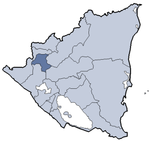Estelí, Nicaragua
|
Estelí Villa de San Antonio de Pavia de Estelí |
|||
|---|---|---|---|

Panoramic of the City of Estelí
|
|||
|
|||
| Nickname(s): "El Diamante de la Segovia" ("The Diamond of the Segovia") name created by Oscar Corea Molina in his radio show "Trampolin 43" | |||
| Motto: "Estelí, amante del presente, forjador del futuro" ("Estelí, lover of the present, builder of the future") | |||
 |
|||
| Coordinates: 13°05′N 86°21′W / 13.083°N 86.350°W | |||
| Country |
|
||
| Foundation | 1685 | ||
| Government | |||
| • Mayor | Francisco Ramón Valenzuela Blandón | ||
| • Vice Mayor | Rosa Argentina Rugama Flores | ||
| Area | |||
| • City | 795.7 km2 (307.2 sq mi) | ||
| Elevation | 843.97 m (2,768.93 ft) | ||
| Population (2005 est.) | |||
| • City | 129,787 (3rd Nicaragua) | ||
| • Density | 144.4/km2 (374/sq mi) | ||
| • Urban | 104,555 | ||
| Climate | Aw | ||
| Website | Official website | ||
Estelí (Spanish pronunciation: [esteˈli]), officially Villa de San Antonio de Pavia de Estelí is a city and municipality within the Estelí department. It is the third largest city in Nicaragua, an active commercial center in the north and is known as "the Diamond of the Segovia"; this name being created by Oscar Corea Molina in his radio show "Trampolin 43"
Located on the Pan-American Highway, 150 km north of Managua, Estelí is a fast-growing and progressive city of about 119,000 people. It enjoys a pleasant climate throughout most of the year due to its location in the north central highlands at a mean elevation of 844 m above sea level. The city is also surrounded by forested mountains of pines, oaks, and walnuts, and plateaus that go up to 1600 m above sea level, some which are protected as natural reserves.
Estelí was the scene of heavy fighting in the civil war against the Somoza government from 1978 to 1979. The city was heavily air-bombed by the regime's National Guard, which reduced many of the city's buildings to rubble. The human casualties were around 15,000; many of them were youths massacred on suspicion of being part of the insurrection. The city was rebuilt but some structures still show bullet holes.
The first settlement of what would become the City of Esteli occurred in Villa Vieja in 1685. It was founded by a group of Spaniards fleeing Nueva Segovia which at that time suffered from pirate attacks. Villa Vieja was then replaced by a new settlement (San Antonio de Pavia) from where the city of Esteli has grown. Today there is evidence of the first church in the Villa Vieja sector of the city.
The town is described in 1858 as "a little town in a small plain through which winds the river of the same name..." It is described as having a grist-mill and that "the country produces considerable wheat of medium quality."
Esteli was described in 1920 as having 8,000 inhabitants and as being a rich and growing center.
The land around Estelí is perfect for growing tobacco for use in cigars, and the town became a refuge for Cuban cigar makers after the Cuban Revolution in 1959. Award winning cigars have made Estelí one of the most important cigar-producing cities in the world. Estelí also has many language schools. Restaurants and hotels cater to tourists traveling to nearby natural reserves and other parts of the region. Natural Reserves around the area include Miraflor, Tisey-Estanzuela, Las Brisas-Quiabuc, Tomabú, Tepesomoto, and Moropotente.
...
Wikipedia



